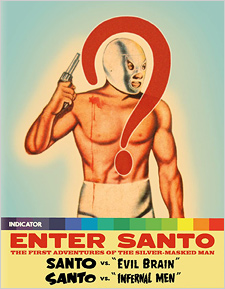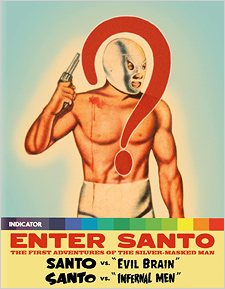Enter Santo: The First Adventures of the Silver-Masked Man (Blu-ray Review)

Director
Joselito Rodríguez, Enrique ZambranoRelease Date(s)
1961 (February 14, 2023)Studio(s)
Agrupación de Técnicos/Azteca Films (Indicator/Powerhouse)- Film/Program Grade: C+
- Video Grade: A-
- Audio Grade: A-
- Extras Grade: A
Review
[Editor’s Note: This review is based upon check discs, not final product. This is also a Region-Free import from the UK.]
Though definitely an acquired taste, Mexico’s Santo films have a peculiar, beguiling charm, working from a uniquely internal logic not unlike Japan’s classic Godzilla movies. In those films, city-thrashing giant monsters that talk to one another, dance little jigs, have tiny priestesses singing songs about them, etc. are simply taken for granted; they’re just casually a part of that equation. Likewise, in the Santo films, no one bats an eye at the thought of a masked, barrel-chested wrestler moonlighting as a crime fighter battling foreign spies, alien invaders, and supernatural monsters. If one can accept movies like these on their own terms, they can be a lot of fun.
One of the great icons of Mexican popular culture, El Santo (born Rodolfo Guzmán Huerta) was the silver-masked wrestling star who, beginning in 1958, concurrently starred in more than 50 feature films made through 1982, two years before his death. In these films El Santo ("the Saint") played a souped-up version of himself; though he never removed his mask in public—except once, fleetingly, in a television interview days before his death—Santo was never regarded as anything less than a civic-minded pillar of his community.
A number of Santo films have been released to DVD and Blu-ray in their original Spanish with English subtitles, but until now the first two Santo films, shot in Cuba in 1958 but not released in Mexico until 1961, have been rather elusive. Powerhouse Films’ Enter Santo—The First Adventures of the Silver-Masked Man is an impressive boxed set not only featuring these first two pictures, but also scads of worthwhile extras, including an excellent feature-length documentary covering the breadth of the Mexican film industry.
Santo vs. the Evil Brain—the onscreen title is El cerebro del mal, though it was marketed in Mexico as Santo contra el cerebro del mal—is barely a Santo film at all. Partly this is because Huerta’s character, known in the film as “El Enmascarado” rather than Santo, is more of a partner to the main masked wrestler-hero, El Incognito, played by Fernando Osés, and even he’s not in the film all that much. The picture was shot (back-to-back with Santo vs. Infernal Men) in the middle of the Cuban Revolution, and not entirely finished when a) the crew ran out of money; and b) was forced to hightail it back to Mexico as Castro’s forces reached Havana.
Back in Mexico, the filmmakers obviously struggled to assemble two marketable movies with so much left undone. Continuity and coherence pretty much go out the window, and the pacing is herky-jerky, with much padding in some scenes, while characters tend to come and go abruptly, without much explanation. Santo appears in less than 15 of the picture’s 72-minute running time, and most of that has him hypnotized or pretending to be hypnotized. In the entire film he probably says less than ten words of dialogue.
The film opens with gangsters ambushing El Enmascarado (Huerta), knocking him out and whisking him to the secret laboratory of respected scientist Dr. Campos (Joaquín Cordero) where he’s transformed into a zombie-like slave. (To what end?) El Enmascarado is, vaguely, some sort of crime-fighting agent working under El Incognito (Osés), another masked wrestler, and police Lt. Zambrano (co-director Enrique Zambrano). Other prominent scientists have recently been kidnapped, so Zambrano assigns bodyguards to protect Dr. Campos, unaware he’s behind the crimes. Also unaware are Gerardo (Alberto Inzúa), Campos’s handsome assistant; and Elisa (Norma Suárez), Gerardo’s girlfriend and Campos’s secretary, the doctor also in mad love with her.
The main appeal of the Santo movies, missing here, is the enormous appeal of El Santo himself. In most of the films, he shares qualities similar to the Lone Ranger and Superman: utter sincerity, unassailable morals, unfailing politeness, a respect for law and order, etc. Just as some cowboy stars of B-Westerns and early television—notably Roy Rogers, William Boyd (Hopalong Cassidy), and Clayton Moore (the Lone Ranger)—virtually became in “real life” the wholesome characters they played onscreen, so too, apparently, did Huerta. Also missing are wrestling rings bouts, intermission-like breaks in the narratives of later Santo movies that allowed the Saint to strut his stuff in the ring.
Conversely, the film has some of the earmarks of the later films. For starters it’s cheap, professionally made but barely so, at times rather threadbare. The Santo films rarely attempted things like special visual effects or elaborate makeups for the monsters and aliens that would turn up later on, and the laboratory in this film is typical of the series, closely resembles those in the ‘60s and early-‘70s pictures, i.e., barely above the level of Ed Wood.
Nevertheless, the film fascinates with its extensive footage of Havana and other parts of Cuba mere weeks before Fidel Castro took over. Viewers will be surprised to find Havana looking very modern, stylish, and attractive—a kind of late-‘50s French Riviera of the Caribbean.
Santo vs. Infernal Men (onscreen title: Santo contra “Hombres infernales”) is even less coherent than Evil Brain. Where the first film has an actual narrative with characters (sketchy as they are) and exposition, Infernal Men has only a vague, largely implied plot concerning contraband (featureless, cigarette-size boxes of stuff, never identified) and the efforts of undercover cop Joaquín (Joaquín Cordero, Dr. Campos from Evil Brain) to infiltrate the gang importing the stuff. Though not competing for screentime with another masked wrestler, Santo once again is barely in the film as an international crimefighter who, once in a while, joins forces with the lawman. In both films he shows up right at the beginning, but then only turns up here and there in little spurts to get Joaquín out of a jam, and in both films he’s completely absent from the post-climax wrap-up.
Clearly the bigger challenge of the two uncompleted films, Infernal Men is heavily padded with footage from the first film and several disconnected musical interludes. Exposition scenes of characters discussing the case or the bad guys discussing their plans are virtually nonexistent, so even the basic plot is inferred, never explicit or adequately explained. Indeed, 80% of the picture plays like second unit footage, with lots of footage of cars driving around Havana, the smuggling boat tooling around the Caribbean, and so forth. The occasional ingenuity of the filmmakers attempting to make this footage play is rather interesting, but it’s hardly a typical or satisfying Santo film.
Both pictures are presented in their original black-and-white, 1.66:1 aspect ratios, restored in 4K from the original camera negatives, each film getting its own disc. As such, both films look great—very sharp with impressive blacks and contrast. The low budget results in some inherent minor technical issues, such as a complete lack of continuity in day-for-night footage, but these are impressive transfers. The LPCM 1.0 mono audio is Spanish only; no English-dubbed versions were ever created, apparently. The optional English subtitles are good and the discs are Region-Free.
The supplements are extensive, toplined by a very impressive documentary worth the price of purchase all by itself. In Perdida (2009, 96:00), filmmaker Viviana García-Besné digs deep into the nearly lost personal and professional history of the Calderón movie empire run by various grandparents, great-grandparents, great-uncles and aunts. They built a movie theater empire that eventually peaked with state-of-the-art movie palaces, and got into production specializing in films with broad popular appeal. As Mexico’s film industry fell into decline, the Calderóns got into the wrestling movie business, including the first two Santo films, and enjoyed a last hurrah of sorts with Carry On-type sex comedies. Appealing to the lowest common denominator, their movies were for decades disparaged by critics and, openly and shockingly, in a public thrashing by the President of Mexico.
It’s a personal, at times revelatory film, even if you need a scorecard to keep track of the various Calderóns and their personal and professional ups and downs, and many of the films and stars discussed will be unfamiliar, though an intriguing subplot is devoted to one Calderón aunt’s romance with actor Ricardo Montalbán. It’s a story full of surprises virtually unknown to those of us north of the border and, I suspect, even most Mexicans. Also included are image galleries from the film.
Other extras include three featurettes: Joaquin Cordero: A League of Gentleman, a 12-minute interview from 2009; The Killer Film: Mascara vs. mascara, a 33-minute piece featuring “The Masked Critic” discussing the genre; and Looking for El Santo, again with Viviana García-Besné visiting the Havana locations used for the two films. It runs 31 minutes. Unavailable to this reviewer is an 80-page book and limited edition poster.
Enter Santo will have limited appeal to general audiences, and even Santo fans will be disappointed by how under-utilized the iconic star is in these films. Nevertheless, this is an outstanding package of material, and for outré film fans, highly recommended.
- Stuart Galbraith IV

